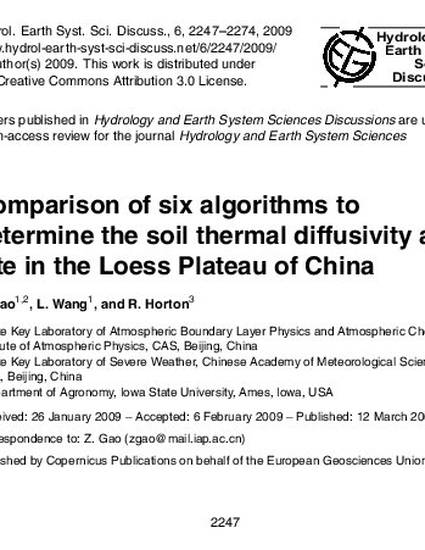
Soil thermal diffusivity is a crucial physical parameter that affects soil temperature. Six prevalent algorithms to calculate soil thermal diffusivity are inter-compared by using soil temperature data collected at the depths of 0.05 m and 0.10 m at a bare site in the China Loess Plateau from DOY 201 through DOY 207 in 2005. Five of the six algorithms (i.e., Amplitude, Phase, Arctangent, Logarithm, and Harmonic or HM algorithms) are developed from the traditional one-dimensional heat conduction equation. The other algorithm is based on the one-dimensional heat conduction-convection equation which considers the vertical heterogeneity of thermal diffusivity in soil and couples thermal conduction and convection processes (hereinafter referred to as the Conduction-convection algorithm). To assess these six algorithms, we (1) calculate the soil thermal diffusivities by using each of the algorithms, (2) use the soil thermal diffusivities to predict soil temperature at the 0.10 m depth, and (3) compare the estimated soil temperature against direct measurements. Results show that (1) HM algorithm gives the most reliable estimates among the traditional five algorithms; and (2) generally, the Conduction-convection algorithm provides the second best estimates. Among all of the algorithms, the HM algorithm has the best description of the upper boundary temperature with time, but it only includes conduction heat transfer in the soil. Compared to the HM algorithm, the Conduction-convection algorithm has a less accurate description of the upper boundary temperature, but by accounting for the vertical gradient of soil diffusivity and the water flux density it includes more physics in the soil heat transfer process. The Conduction-convection algorithm has potential application within land surface models, but future effort should be made to combine the HM and Conduction-convection algorithms in order to make use of the advantages of each.
Available at: http://works.bepress.com/robert-horton/38/

This article is published as Gao, Z., L. Wang, and R. Horton. 2009. Comparison of six algorithms to determine the soil apparent thermal diffusivity at a site in the Loess Plateau of China. Hydrol. Earth Sys. Sci. Discuss. 6:2247-2274. Posted with permission.